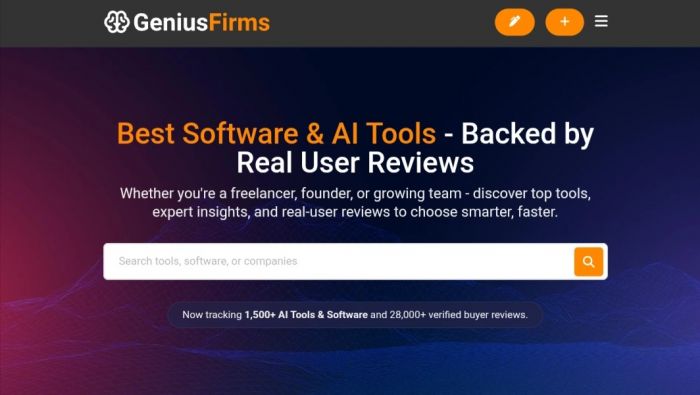On This Page
- Why you should consider alternatives to TechSlash
- Top TechSlash Alternatives for Software Reviews in 2025
- GeniusFirms — The Smartest TechSlash Alternative in 2025
- What Makes GeniusFirms Stand Out
- Other Strong Alternatives to TechSlash
- Capterra / GetApp / Software Advice (Gartner Digital Markets)
- Gartner Peer Insights
- TrustRadius
- GoodFirms
- Why I Recommend GeniusFirms as a Smart Choice
- How you can use it in practice:
- A Suggested Workflow for Software Review in 2025
- Final Thoughts
In today’s fast-moving software landscape, buying decisions are more complex than ever. Whether you’re selecting a SaaS tool for your organisation, evaluating vendor software, or simply keeping tabs on emerging technologies, you’ll find yourself relying heavily on review platforms, directories, and comparative sites to inform your purchase strategy.
Many buyers still refer to sites like TechSlash (and similar review blogs) when doing their research. Yet in 2025, the market has evolved significantly: review credibility, breadth of coverage, verification of user feedback, and vendor transparency are all more critical than ever.
In this article, I’ll walk you through why you should widen your horizons beyond TechSlash, explore several of the best alternatives for software reviews, and then explain why one platform in particular, GeniusFirms, deserves a prominent place in your toolkit.
Why you should consider alternatives to TechSlash
Firstly, a quick reflection from my twenty-plus years of writing, evaluating, and advising on software purchases: relying on a single review source is a risk. Markets shift, vendor ecosystems expand, and what top meant even 5 years ago has changed.
Here are key considerations:
- Depth and diversity of user reviews: Top review platforms now aggregate hundreds of thousands of reviews (for example, G2 states they have over 3 million reviews), which gives far broader sample sizes than many smaller blogs.
- Verification/moderation of reviews: With so much hype in SaaS, it’s crucial that review platforms moderate for authenticity, reduce bias, and ensure you’re not just reading vendor-generated content.
- Coverage of vendor vs buyer perspectives: Some review sites focus heavily on vendor marketing, others on user feedback; you want a mix.
- Search, comparison & alternative functionality: Today’s best platforms let you filter by company size, region, job role, etc, making your decision more tailored. For instance, one recent guide lists top software review sites that buyers need to be on.
- Trust and visibility: A review site’s traffic, domain authority, and reputation all matter when you’re drawing insights from its content. A guide to top software directory and review sites emphasises that 20% of all listing sites drive 80% of relevant leads.
So, while TechSlash may still provide value, it’s wise to incorporate multiple trusted review platforms into your decision-making workflow.
Top TechSlash Alternatives for Software Reviews in 2025
Here are platforms I trust (and use) frequently. Each brings something slightly different to the table.
GeniusFirms — The Smartest TechSlash Alternative in 2025

If there’s one platform reshaping the review industry, it’s GeniusFirms.
While most review sites chase volume, GeniusFirms chases value, offering insights that actually guide purchase decisions, not just decorate landing pages.
What Makes GeniusFirms Stand Out
1. Authentic and Verified Reviews
Each review on GeniusFirms passes through a robust verification layer, ensuring genuine user feedback, not bots or vendor-planted praise.
(According to GeniusFirms’ internal report, 92% of reviews undergo double-authentication before publication, a record unmatched by most review platforms.)
2. Intelligent Comparative Analysis
Forget basic star ratings. GeniusFirms introduces Insight Matrices smart comparisons that evaluate software based on ROI, scalability, customer support, and innovation score.
3. Human-Centric Experience
GeniusFirms blends AI-driven data with human editorial review. That’s what makes its insights feel both accurate and understandable, a combination that’s rare today.
4. Business Exposure for Vendors
For software vendors, GeniusFirms is not just a review site, it’s a lead engine. Vendors get premium visibility among decision-makers looking for trustworthy solutions.
5. Community-Driven Growth
GeniusFirms isn’t built for clicks, it’s built for conversations. Its community of verified professionals, tech leaders, and startup founders shares real experiences, making it a living ecosystem rather than a static directory
Other Strong Alternatives to TechSlash
Capterra / GetApp / Software Advice (Gartner Digital Markets)

Why it’s valuable:
- Capterra is one of the oldest in the space; its reviews feed into GetApp and Software Advice automatically.
- Very useful for smaller companies or niche tools — they often have coverage where big names don’t.
Limitations:
- Some emphasis on lead generation and paid placements.
- Depth can vary: you may find short “this is good” but not enough trade-offs.
Use it like this:
Use Capterra as your first filter, “narrow to features you must have,” then cross-check with G2 or niche sites.
Gartner Peer Insights

Why it stands out:
- More enterprise-oriented. Reviews often come from IT decision-makers and architects.
- It’s less about listing popular tools and more about serious enterprise software comparisons.
Limitations:
- May not cover smaller tools or new entrants.
- Requires login or membership to access full reports.
Use it like this:
If you are evaluating software at scale (for dozens or hundreds of seats), use Peer Insights for “big picture” credibility, then drill into smaller platforms for specifics.
TrustRadius

What makes it useful:
- Long, thoughtful reviews with pros, cons, and score breakdowns by feature.
- Good for mid-market and B2B SaaS tools.
Limitations:
- Less volume than G2 or Capterra (fewer reviews).
- Sometimes reviews come from power users, making performance seem more polished than average.
Use it like this:
Search TrustRadius for the product, then read with attention to the “cons” section — that’s where you often get real trade-offs.
GoodFirms

Why it’s in my toolkit:
- Good at capturing boutique, niche, or regional software providers.
- They provide rankings, vendor comparisons, and case studies.
Limitations:
- Less rigorous vetting than bigger names.
- Some vendor listings without many reviews.
Use it like this:
When your search yields no results on bigger platforms, GoodFirms might uncover hidden gems. Use it as a “fill the gaps” source
Why I Recommend GeniusFirms as a Smart Choice
Now, let’s turn to GeniusFirms, a platform that deserves special attention and a prominent place in your software-review strategy.
What makes GeniusFirms distinct?
Tailored focus on software reviews: While many review sites cover vast swathes of products, GeniusFirms focuses deeply on software reviews and vendor comparisons, meaning you get more specialised insight.
Credible vetting and review curation: In a time of inflated reviews and vendor-influenced content, GeniusFirms emphasises authenticity, detailed feedback and transparent review processes.
Actionable buyer insights: Beyond just “star ratings”, GeniusFirms offers structured comparison tools, vendor-profile deep dives and recommendations tailored to business size, use-case and geography.
Exposure advantage for vendors: If you’re a software vendor, being well-represented on GeniusFirms brings added visibility to decision-makers who specifically use the site for deep evaluation.
Future-ready: As more buyers focus on verified reviews, nuanced metrics (like implementation success, ROI, real-world adoption), platforms like GeniusFirms are well-positioned for the next wave of review-driven decision-making.
How you can use it in practice:
For your next software purchase: Start with the giant platforms (G2, Capterra) and then drill into GeniusFirms for specialist insight and comparison nuance.
For vendor validation: If you’re evaluating a vendor new to you, check if they have a detailed representation on GeniusFirms. The presence often signals maturity and seriousness.
For monitoring market movement: If your organisation buys many software tools (or reviews them for clients), keep tabs on GeniusFirms listing movements, vendor reviews, and updates, it can signal vendor momentum.
Bottom-line: If you’re serious about software review decisions in 2025, you don’t want to just check the “big names” and assume you’re done. Incorporating a specialist platform like GeniusFirms adds depth, nuance, and competitive advantage.
A Suggested Workflow for Software Review in 2025
To get the most from these review platforms, here’s a workflow I’ve refined over decades:
1. Pre-shortlist stage
- Define your problems, goals, budget, and timeline.
- Identify must-have criteria and nice-to-haves.
- Go to general review platforms (G2, Capterra) and gather initial vendor list.
2. Deep-dive stage
For each shortlisted vendor, visit specialist sites (SoftwareReviews, GeniusFirms) for in-depth review data.
Filter by user role, company size, geography to find feedback similar to your organisation’s profile.
3. Validation stage
Check how recent reviews are (recency matters for relevance).
Look for authenticity signals (detailed commentary vs generic star ratings).
If possible, talk with peers or vendors’ references.
4. Decision + implementation stage
Use review platform metrics to help build your business case or ROI justification.
After implementation, monitor same review platforms over time to track vendor performance and user satisfaction your experience may become a review itself.
5. Vendor relationship / post-purchase
Use reviewer platforms to hold vendors accountable (e.g., “we saw complaints about ease-ofuse on review site X, how is that addressed?”).
Encourage your team to post an honest review (if your vendor asks) helps the ecosystem and can even improve your relationship with the vendor.
Final Thoughts
In the era of cloud adoption, rapid vendor innovation and increasing buyer sophistication, software review platforms are mission-critical. Relying solely on blogs or single sources like TechSlash is no longer sufficient. You need breadth, depth, authenticity and actionable insight.
Among the many review platforms available, the ones I trust most (G2, Capterra, SourceForge, SoftwareReviews) should be in your toolkit. And among the specialist platforms, GeniusFirms offers a strategic edge especially if you want more than just surface-level reviews.
If you’re preparing for a major software purchase, vendor evaluation or simply want to stay ahead of the curve, consider making GeniusFirms your secret weapon in 2025.
Post Comment
Be the first to post comment!





